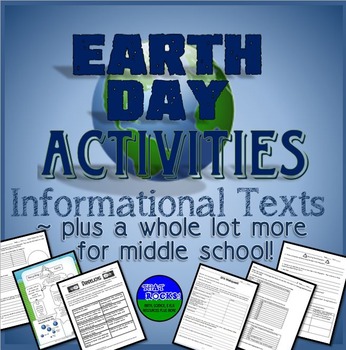7 Earth Day Activities : Informational Texts Plus More!
- PDF
- Easel Activity
What educators are saying
Description
Earth Day Activities! Informational Texts Plus More. These informational texts also make great practice for standardized test!
Celebrate Earth Day's 53rd anniversary! Earth Day is officially on Monday, April 22, but you can celebrate all week by reading nonfiction texts and doing corresponding activities: The Plastic Problem, Water Wisdom, and Go Green! The Power of Renewable Energy. There is also a Recycling Facts Infographic, an Endangered Species Webquest, a dripping water lab, a Dandelion argument activity, and a factual recycling logic puzzle.
This product has been updated with the EASEL feature, perfect to use with distance or virtual learning! It can be assigned to students in a Google Classroom. You can either use the digital overlay already created, or create your own! For more information, read here!
The Plastic Problem is one page long, with a page of questions and a Math Connections/ story problems worksheet. (Knowledge of ratios is helpful!)
Water Wisdom is one page long, with a page of questions, 2 pages of student-made graphs (pie graphs and bar graphs) a United States map activity, and the Wasteful Water Activity (a hands-on experiment).
Go Green! The Power of Renewable Energy is a two-page article that explains wind energy, solar energy, geothermal energy, bioenergy, and hydropower, and how they are used to generate electricity. It comes with two pages of questions.
The Recycling Facts Infographic is useful not just for reading facts, but applying critical thinking to the information. Following it is a list of Unusual Recycling Project Ideas.
The Endangered Species Webquest teaches students about which animals are threatened, endangered, vulnerable, and of least concern. It also covers endangered plants, endangered species that have made a comeback, and newly discovered species in 2017.
Dandelions: Intolerable Intruder or Favorable Flower has students read statements and which category they fit into. Students must then give an opinion on whether or not dandelions should be weeded out or allowed to grow.
The recycling logic puzzles have students solve for the percent of 10 different materials that were recycled in 2012.
The use of all the activities included could take a week, depending on your class length.
See the preview a full look at everything included in this resource (without the answer key.)
***Check back periodically to see what activities have been added. A few more ideas are still in the works!
Click on the green star above to become a follower of our store and receive updates of new products and sales!
Also, don't forget to give feedback on the product to earn TpT credits.
Thanks! Your business and feedback are greatly appreciated!






